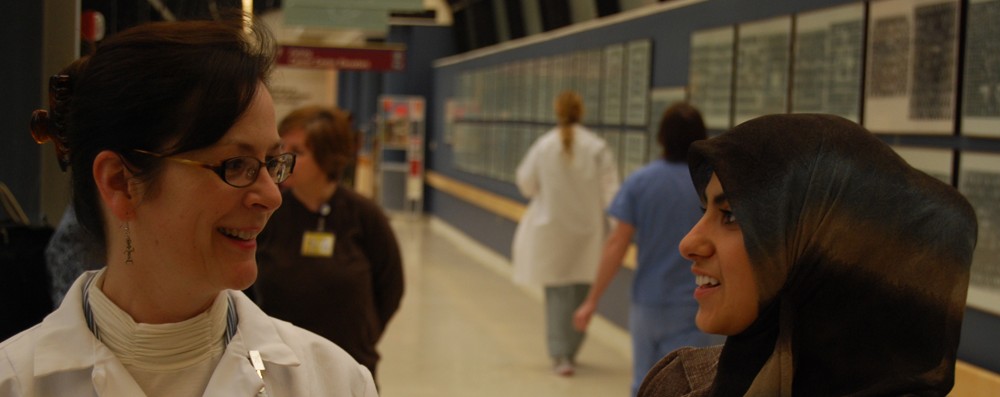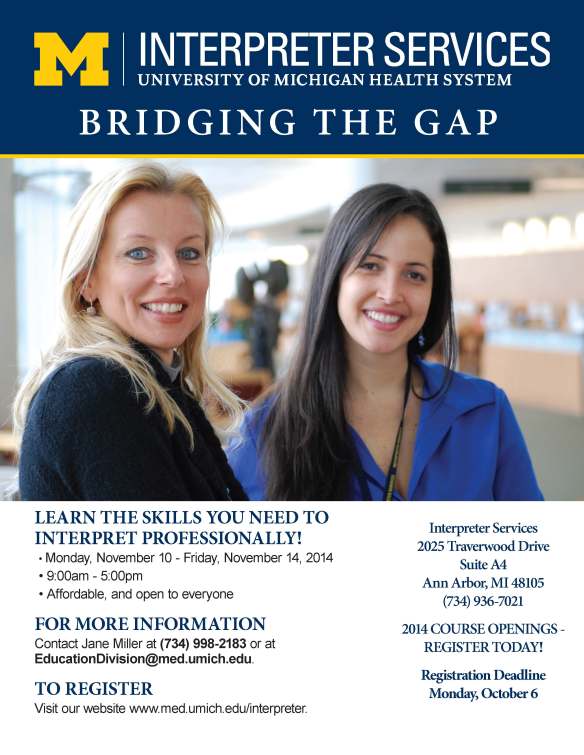Tag Archives: Interpreter Training
Summary from IMIA Lifelong Learning Webinar Series: Cultural Influences in Organ Donation
When dealing with organ/tissue donations, it is important to understand both the dynamics and the processes involved. Why do the hospitals participate? Under federal mandates they are compelled to participate if they are receiving, or want to receive, federal funds; otherwise, they will lose the capacity to receive federal financial support. Hospitals also participate in organ donation because they are in the business of saving lives. Hospitals, which have access to families and medical organizations, are in permanent contact through collaborative relationships with Organ Procurement Organizations (OPO); certification is required to be involved in organ/tissue donation.
Even though potential organ/tissue recipients are all ages, deceased donors are not proportionally distributed by age: about 20% are over 64 years old, 46% between 50 and 64, 24% between 35 and 49, 9% between 18 and 34, only about 1% between 11 and 17, and less than 1% is younger than 10 years old. These numbers are indicative of the current potential waiting patients, especially for relatively young donors.
Culture and religion are very important factors to consider when dealing with potential donors. Culture is not stagnant – it is fluent, alive, and changing as people. It moves, migrates, and evolves and, along with religion (religious attitudes, beliefs, and practices) it can affect a family’s response to possible donation for transplant. The speaker presented different cases to show that assumptions cannot be made on the response of a given family to organ donation based on the cultural background and/or the teachings of a particular religion. The lesson here is that what it is true for one person or one family is not necessarily true for every person or every family.
One example that clearly illustrated this issue was a Muslim family that decided against donation on the grounds that the whole body has to be buried. Islam is a religion that encourages organ donation, in fact, considers it an act of merit, and, in certain circumstances, even an obligation. Another case that was presented involving a different Muslim family was one of a deceased man who’s only family in the USA was his widow. In that case, both the widow and friends of the deceased decided in favor of donation by acknowledging an earlier decision made by the deceased. These two cases, among others involving families following other religions and having different outcomes, stress the need to always ask for donation.
It was also mentioned that some African-Americans fear unequal access to and care at healthcare facilities and hospitals and that they show up in big groups of people, in a similar way as is common in Hispanic or Latino families. No direct information was available regarding Asian cultures other than that there is a strong tendency to honor their ancestors. It is frequently the inability to release patients for donation since this might affect their relationship with their ancestors.
These examples bring up two very important issues to consider while discussing organ donation: 1) who are we approaching for donation? and 2) how are we approaching them? In a pediatric setting, it is convenient that the person approaching the family and asking for the donation be the attending physician, after speaking with organ procurement staff and determining what organs/tissues are suitable for donation, as well as which would be the best time to approach families. Interpreters do not ask for donations: they just interpret the discussion between the families and the care provider. Organ coordinators are the ones in contact with the family at any time both for comfort and help with any need.
Where is the family? Where is the interpreter? There is a strong need for evaluation and revision of these questions in every situation. For example, in the case of a homicide, a suicide, or a car accident where an autopsy is needed, a medical examiner from the prosecutor’s office will have their word before the family. It is in this latter context that the concept of brain death might be more important. Brain death refers to the irreversible sensation of the brain function (there are different protocols to define brain death). The brain function (brain flow – flow of blood in the brain) is used to know how the body is doing (dead or alive). The legal date/time of death is the date/time of the brain test that determined that the brain is dead. One of the most difficult circumstances experienced by the speaker was the case of a brain-dead young woman whose father and family wanted to donate her kidneys while still saying goodbye. Brain dead persons are taken to the operating room with all necessary materials, and it is there that the ventilator, with the family members present, is removed. There is a ninety minute period for the heart to stop beating and then, the family has five minutes for themselves with the deceased. Since it is a critical situation, only two family members are usually allowed to be present in the operating room; however, in a case like that it was very difficult, given the circumstances, to make the decision of who will be allowed into the operating room: boyfriend, sister, father, mother; all of them were very close to the deceased and wanted to be with her until the last moment.
There is need to consent for donation, and different organizations handle different situations: living organ donations are handled by transplant organizations; deceased organ donations by organ procurement organizations; and tissue donations by the Federal Drug Administration. Registration for donation can be made through the State Department of Motor Vehicles, then everything is donated; or submitted online through the Online Donor Registration, which allow several donation options: tissue, organ, both organ and tissue, and also the possibility that those organs/tissues not used for transplant might be used in research studies. The strategy followed to address organ/tissue donation from deceased patients has an established pattern: (1) Introduction of who we are; (2) Condolences; (3) Ask/Tell who we are. Interpreters/Staff should be very upfront if uncomfortable on a particular situation. The fact that a person/family is religious or non-religious does not imply organ donation acceptation or rejection; donation is a very personal matter. There is never a guarantee for donation or non-donation. Not all deceased persons are suitable for organ donation but, even if not, their bodies can still be very useful for tissue donation. The speaker introduced here the personal case of her late husband who was able to donate his two corneas and also help 45 additional patients who were in need of bone tissue, thus helping a total of 47 persons.
In the US, a Social Security Number is needed to recover body/organs. It is unclear if they are recoverable from illegal aliens (depends on the laws in each individual State). Organs and tissues are not recoverable if HIV positive, unless there are HIV positive or AIDS patients on the waiting lists. The cultural impact of the possibility of using cloned organs (eliminating the wait for deceased organ donation) tends to bring lots of negativity from religious organizations because of potential unknown long-term medical effects.
To summarize, the main lessons learned from this webinar were that:
- Hospitals with federal funds are required to participate in organ donation.
- Culture and religion are not stagnant; they are fluid and changing.
- It is essential to not stereotype.
- Organ/tissue donation can help families in the process of grieving.
And it is very important to contact experts in the area to protect Interpreters and Hospital Staff and to prevent any possible violations of the current laws and regulations on the subject of organ and tissue donation.

